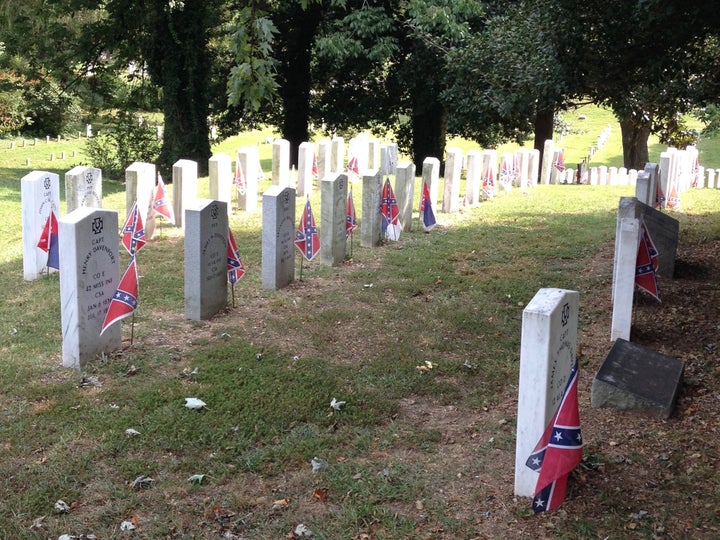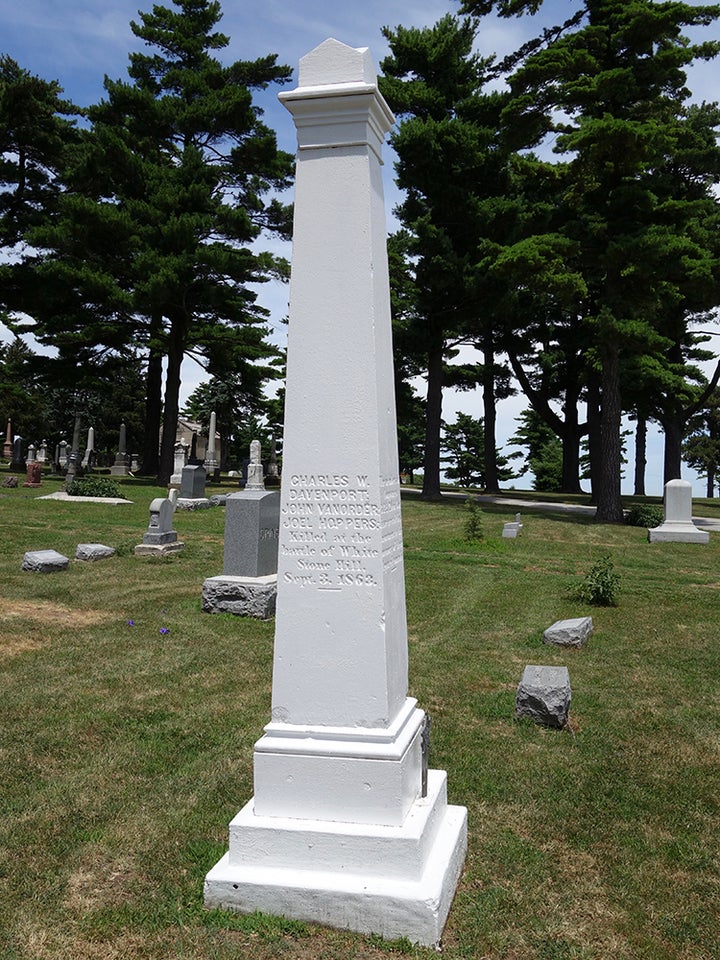
Hollywood Cemetery, Richmond, Virginia
Monday night, a group of about 100 people in Durham, North Carolina threw a rope around the statue of a Confederate soldier and pulled it off the pedestal where it has stood in front of the Durham County Courthouse for nearly a century. Unlike the statue in Charlottesville, Virginia, this statue did not purport to honor the generals or politicians that led the Confederacy. Instead, it was dedicated to “the memory of the boys who wore the gray.” North Carolina governor Roy Cooper tweeted: “The racism and deadly violence in Charlottesville is unacceptable, but there is a better way to remove these monuments.”
I think it is important for all of us to remember that we are talking about several different things simultaneously, and when we conflate them, we lose any opportunity to find common ground and move forward.
The white nationalists that went to Charlottesville last week, taking advantage of the laws of an open carry state to arm themselves like paramilitaries, used the city’s vote to remove the statue of Robert E. Lee as an excuse. They were there to intimidate and to loudly proclaim that they believe that the election of Donald Trump as president of the United States was a signal that their views of racial superiority, of the morality of institutionalized privilege, are ascendant. They are wrong. I believe that the vast majority of Americans, including many of those who voted for President Trump, agree that they are wrong.
I am a member of the Democratic Party. I have never voted for anyone other than a member of the Democratic Party. My liberal bonafides are strong. And yet, as trite as it is to say, I have many friends who are Republicans. I don’t believe any of them are consciously racist. If I did believe them to be consciously racist, they wouldn’t be my friends. (Implicit bias is an entirely different thing, but I think that failing to recognize your own privilege is a far lesser sin than conscious racism.)
I am a northerner who has been living in the South for the past seven years. I have had friends in the North tell me that they could never move south of the Mason-Dixon line because the southern states are so racist. I teach property law at Wake Forest Law School, and as part of that class I teach fair housing laws and tell my students the story of racially exclusive restrictive covenants, redlining, block busting, and other tactics used for years to create segregated neighborhoods. Perhaps those friends in the North believe that these were exclusively southern strategies. They were not. Indeed, less than half of the most segregated cities in the United States in 2017 are located in the old Confederacy. The two most segregated cities in the United States are Detroit and Chicago. Cleveland is fifth and Buffalo is seventh. These northern industrial cities were intentionally segregated, by private actors and by the local and federal governments, in response to the Great Migration. Many violent and horrific struggles in the civil rights movement occurred in the South, but we cannot forget that desegregation in schools was not exactly accepted with grace and dignity in many places in the North.
I am a native of Indianapolis. The Soldiers and Sailors Monument, a memorial to the Hoosiers who died fighting for the Union in the Civil War, is literally the center of the city. Yet, I cannot forget that in 1922, the Indiana General Assembly voted to institute a Klan Day at the Indiana State Fair, including a nighttime cross burning. (The bill was thankfully vetoed by the governor.) The Klan was a force in the General Assembly because in the early 1920s, nearly 30 percent of the native-born white men in Indiana were members.
I am the great-great-granddaughter of a half-dozen men that fought for the Union in the Civil War. I had ancestors that lived in the South but they’d all moved north by the time of the Civil War. Fun fact: through one of those families, the Bowles family, I am Barack Obama’s sixth cousin. The Bowles family owned slaves in Virginia and Kentucky. They moved to Illinois in the 1850s. I can find no record that they freed their slaves before they left. As far as I can tell, they sold their slaves to finance their relocation north.
I’ve visited the National Archives to examine the service records of my Union ancestors. It was enlightening. John Henry Conrad, born into a farming family in Scott County, Illinois, lost his mother at the age of 2 and his father at the age of 9. He enlisted in the 38th Illinois Infantry in September 1861. Wounded at Stone River, Tennessee, he re-enlisted and was captured at Chickamauga and imprisoned at Andersonville until the end of the war. He suffered greatly at the hands of the Confederate Army. Yet I have to ask, was John Henry Conrad motivated to enlist and re-enlist because he was an abolitionist or believed strongly in the Union cause? Perhaps. I’ve seen nothing in our family history to believe that to be true. Instead, I wonder whether that landless, orphaned boy, who grew up on the charity of neighbors, would have enlisted in the Confederate Army if he had been born south of the Mason-Dixon line.
Pharagus Pollard was born in White County, Tennessee but moved with his family to Nebraska in the late 1850s. He enlisted in the Second Nebraska Cavalry in November 1862. His unit was not sent East to fight Johnny Reb. Instead, they were sent North to defend the western border of the United States from the Sioux. Pharagus died in July 1863 from dysentery at Dakota Camp No. 13. He is buried somewhere in South Dakota but there is a memorial in Steele Cemetery, Falls City, Nebraska, to him and the other members of his company that did not make it back home.
A few months after Pharagus died, the Second Nebraska Cavalry fought The Battle of Whitestone Hill against the Sioux. I should say, the United States of America calls it the “Battle” of Whitestone Hill. What actually happened was that on September 3, 1863, Brigadier General Alfred Sully ordered 1,200 Union troops to attack a Sioux village. There were Sioux warriors present in the village, estimates vary from 600 to 1,500, but there were also 2,000 to 3,000 women and children. According to the history curriculum approved by the North Dakota state government, which refers to the encounter as the “Massacre” of Whitestone Hill: “While some of his soldiers surrounded the camp, [General] Sully led the charge into the village. They encountered [Dakota leaders] Little Soldier and Big Head. Pahtanka tried to surrender by waving a white cloth. Though the Dakotas had been peacefully hunting, and did not fight, soldiers killed some old men, women and children in the camp. Those remaining in camp were taken prisoner.” Records indicate that some 500 to 600 people in the village were killed by the Union Army. Some of the Union soldiers whose names appear on the monument in Steele Cemetery “fought” in the “Battle” of Whitestone Hill. I’ve found surviving letters from the late 1860s and 1870s between members of the Pollard family in Nebraska and members of the Pollard family who stayed behind in Tennessee. Many of the young men in my family who stayed in Tennessee fought for the Confederacy. I have a hard time rationalizing that Pharagus’ service against the Sioux was less of a sin than his cousins’ service against the Union. And let us not forget that the Union Army that was built to fight the Confederacy was turned against the Plains Indians after the war was over to dispossess them of their land. There was plenty of sin to go around.

Steele Cemetery, Falls City, Nebraska
I grew up believing that the Civil War was fought to end slavery. I grew up believing that the South seceded following the election of Abraham Lincoln because he was going to end slavery. Neither of those are true. The South wanted to maintain a balance of free and slave states in order to maintain their political power in Congress. Southern slaveholders feared the loss of power for many reasons, including a rational fear that if Northern abolitionists could eventually sway their representatives to vote to abolish slavery, the South wouldn’t have the votes to stop it. But abolition was by no means imminent. Abraham Lincoln’s views on slavery evolved, but his public position until he issued the Emancipation Proclamation was that slavery should not be disturbed in the existing slave states. (Let’s not forget that on September 22, 1862, President Lincoln warned the Confederate states that if they did not rejoin the Union before January 1, 1863, he would free their slaves. If they had timely surrendered, he would not have issued the Emancipation Proclamation. It was as much an act of political/military strategy as an act of moral courage.) And since I’m destroying illusions, I hate to tell you this, I really do, but Abraham Lincoln was, like many white men of his day, a stone-cold racist.
At the fourth Lincoln-Douglas debate, held in Charleston, South Carolina, the “Great Emancipator” began with the following [transcript courtesy of the National Park Service]:
“While I was at the hotel to-day, an elderly gentleman called upon me to know whether I was really in favor of producing a perfect equality between the negroes and white people. [Great Laughter.] While I had not proposed to myself on this occasion to say much on that subject, yet as the question was asked me I thought I would occupy perhaps five minutes in saying something in regard to it. I will say then that I am not, nor ever have been, in favor of bringing about in any way the social and political equality of the white and black races, [applause]-that I am not nor ever have been in favor of making voters or jurors of negroes, nor of qualifying them to hold office, nor to intermarry with white people; and I will say in addition to this that there is a physical difference between the white and black races which I believe will forever forbid the two races living together on terms of social and political equality. And inasmuch as they cannot so live, while they do remain together there must be the position of superior and inferior, and I as much as any other man am in favor of having the superior position assigned to the white race. I say upon this occasion I do not perceive that because the white man is to have the superior position the negro should be denied every thing. I do not understand that because I do not want a negro woman for a slave I must necessarily want her for a wife. [Cheers and laughter.] My understanding is that I can just let her alone. I am now in my fiftieth year, and I certainly never have had a black woman for either a slave or a wife. So it seems to me quite possible for us to get along without making either slaves or wives of negroes. I will add to this that I have never seen, to my knowledge, a man, woman or child who was in favor of producing a perfect equality, social and political, between negroes and white men. … I will also add to the remarks I have made (for I am not going to enter at large upon this subject,) that I have never had the least apprehension that I or my friends would marry negroes if there was no law to keep them from it, [laughter] but as Judge Douglas and his friends seem to be in great apprehension that they might, if there were no law to keep them from it, [roars of laughter] I give him the most solemn pledge that I will to the very last stand by the law of this State, which forbids the marrying of white people with negroes. [Continued laughter and applause.]”
We live in 2017, not the 1860s. The Civil War has been over for a long time and we should let it be over. We have to stop pretending that the Union Army was composed entirely of dedicated abolitionists who believed in equality and fought against those racist bastards in the South. There were racists in the North and the South in the 1860s. There were racists in the North and the South in the 1920s. There were racists in the North and the South in the 1960s. There are racists in the North and the South today. The Confederate States of America is not the enemy. They were defeated. Slavery was defeated. Racism has not been defeated. White supremacy has not been defeated. So let us shine a bright light on those white nationalists who believe that their views are once again ascendant and let us, ALL of us, in the North and the South, in the Democratic Party and the Republican Party, tell them that their day is past.
A North Carolinian mob pulling down a monument to “the boys who wore the gray” is counter-productive. It makes it more difficult to have a rational conversation about what is really important for us to finally move forward as a country: ending institutionalized racism. Maybe the only way to take the Civil War off the table is to remove ALL of the monuments—those to the Union and those to the Confederacy. Because let me tell you, as much as I love the Soldiers and Sailors Monument in downtown Indianapolis, I don’t feel too great about that memorial to the men of the Second Nebraska Cavalry, even if one of them was my great-great-great grandfather.
